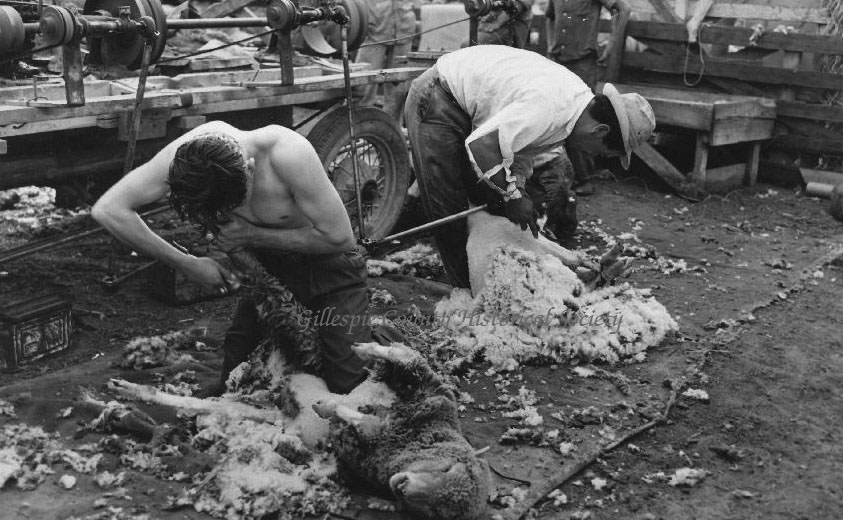
Sheep shearing is really a show, when done by experts. Photo courtesy Gillespie County Historical Society, Fredericksburg TX.
April 15, 2015–Readers sometimes ask what is the best show I have ever seen. Well, it happened in a dusty cattle barn on a cold January morning.
My kids and I had taken in our three goats to be sheared in preparation for the stock show. We arrived at 7:30 a.m. so we would be first in line for the 8:00 start.
The shearer didn’t show up at 8:00. Or at 8:30. Or 9:00. Finally, at 9:30, a tan ’88 Oldsmobile with one brown fender and no shocks roared into the fairgrounds in a cloud of blue smoke. Out popped a very short, very round man with skin the color of the car. He had slick gray hair pulled back in a ponytail and a thin handlebar mustache.
Instead of apologizing for being late, he inclined his head and smiled at the now large crowd of parents and kids.
Like a magician preparing his act, he opened the sagging trunk and began hauling out an assortment of metal parts. To our amazement, Max (we knew it was his name because it was stitched in fine white wire on a mysterious black leather pouch hanging from a silver riveted belt) began to assemble these pieces into his shearing contraption.
“It is like a jigsaw puzzle,” he explained amicably, while refusing assistance from the eager ranch dads.
With practiced efficiency, Max proceeded to put together a seven-foot frame of rusted and well-used square pipe, fitted with a gangly metal double-jointed arm. He lifted out a motor bolted to a board, and gently wrestled it inside the frame, lining up four holes in the wood with corresponding bolts.
“If you put it the wrong way, it won’t work,” he graciously explained.
Instead of threading nuts on the four bolts, he strapped a rubber cord with hooks around it to hold it in place.
“That way is faster than using nuts,” he said.
To our growing wonder, he attached two wheels to one end of the rig, and wheeled it inside the barn, again refusing all help from the hovering parents. Jockeying it into position, Max requested two 4×8 panels, which were duly fetched and placed on the ground as a platform.
Patiently, yet purposefully, Max arranged his workspace, using every type of fastener. He clipped the power cords to the frame using vise grips. From two short pieces of ropes ending in snap clips, he hung a can of oil, and a can of grease. He draped a leather thong over the frame–use unknown. He pulled out a battery-operated clock and slipped it into a pouch taped to the rig. He lashed a digital counter to another section using a leather cord.
The drama was not over. Surveying the now large crowd of dads, moms, and fascinated 4-Hers, Max peeled off his leather jacket. To our relief, he wore a shirt underneath, though it was sleeveless and had the buttons opened far enough to reveal a heavy silver cross hanging from a chain.
Surely, the shearing could begin?
Not quite.
“And now,” he announced with the grace and presence of an impresario, “I am almost ready. I just need one more thing… The most important thing.”
He flipped up the flap of that black pouch and drew out a cellophane-wrapped cigar. He reached around a hidden corner and produced a hitherto unnoticed cigarette lighter, attached–of course–with a magnet.
Unwrapping and lighting the cigar, he said, “Now, I am ready!”
The crowd almost burst into applause. The wait was forgotten in awe of the performance.
Max proceeded to shear our three goats in approximately nine minutes.
The leather cord? It was used for starting the electric motor as well as for tying the goats’ feet.
It cost me $5 per goat. A bargain, for a front row seat to the best show I’ve ever seen.